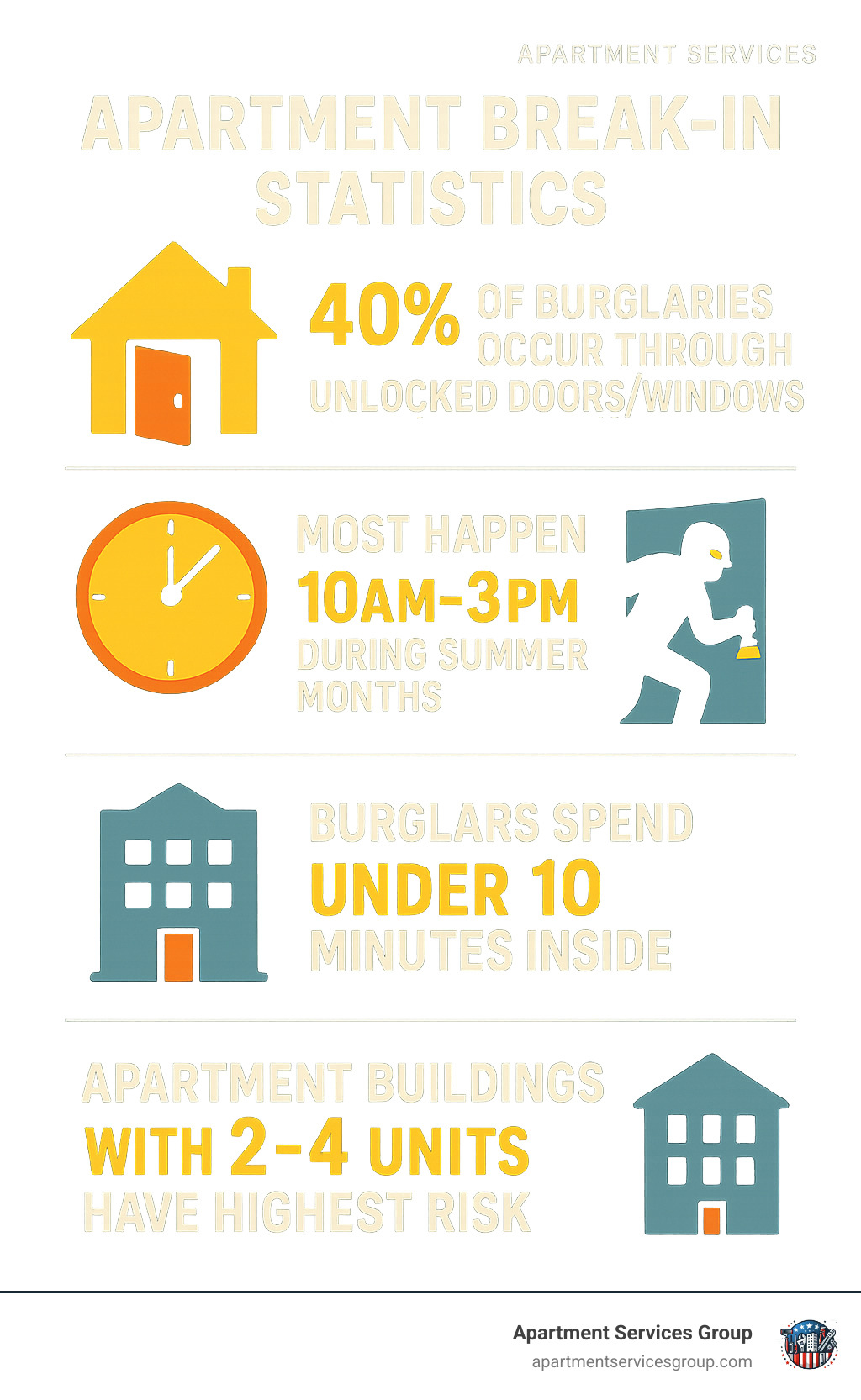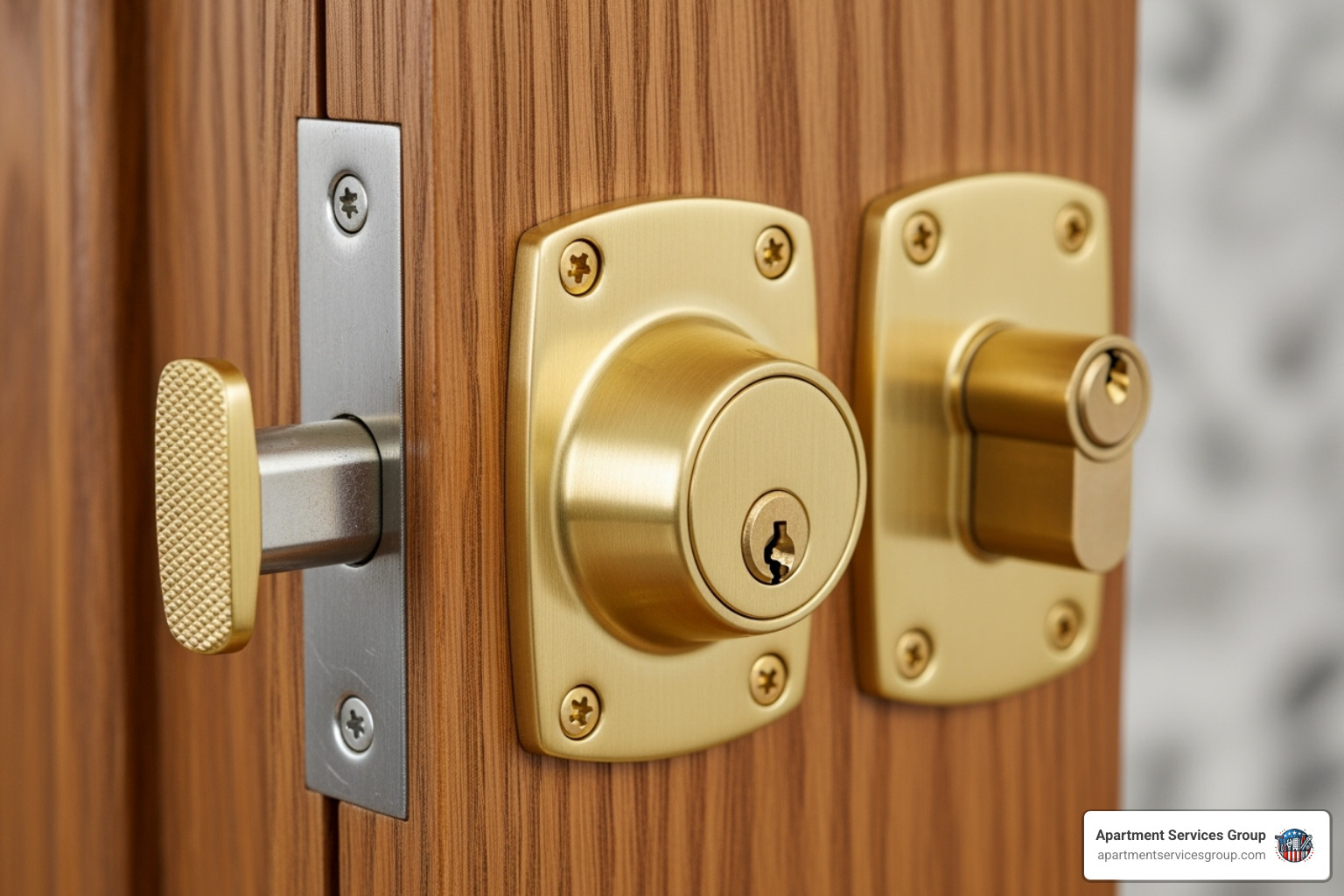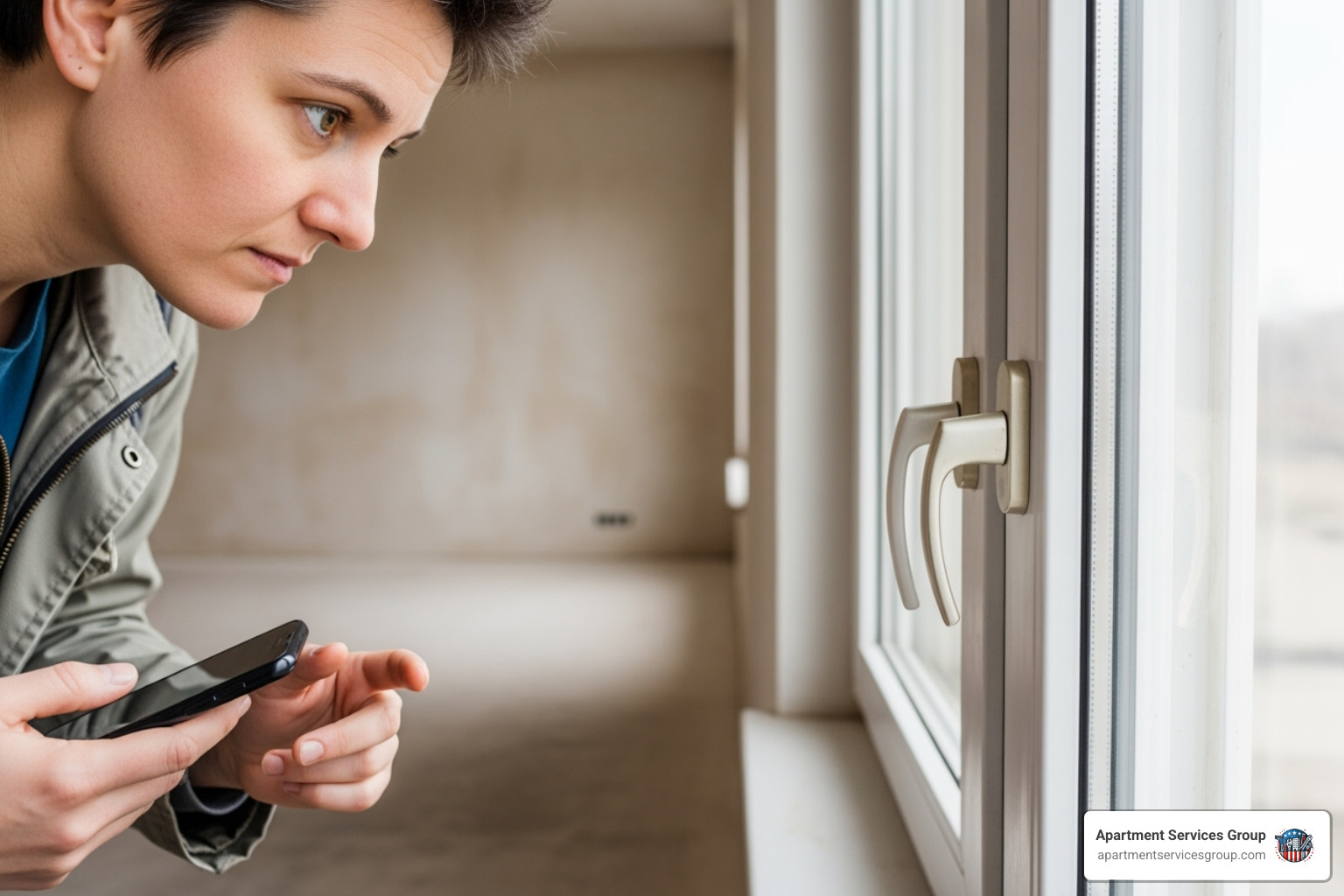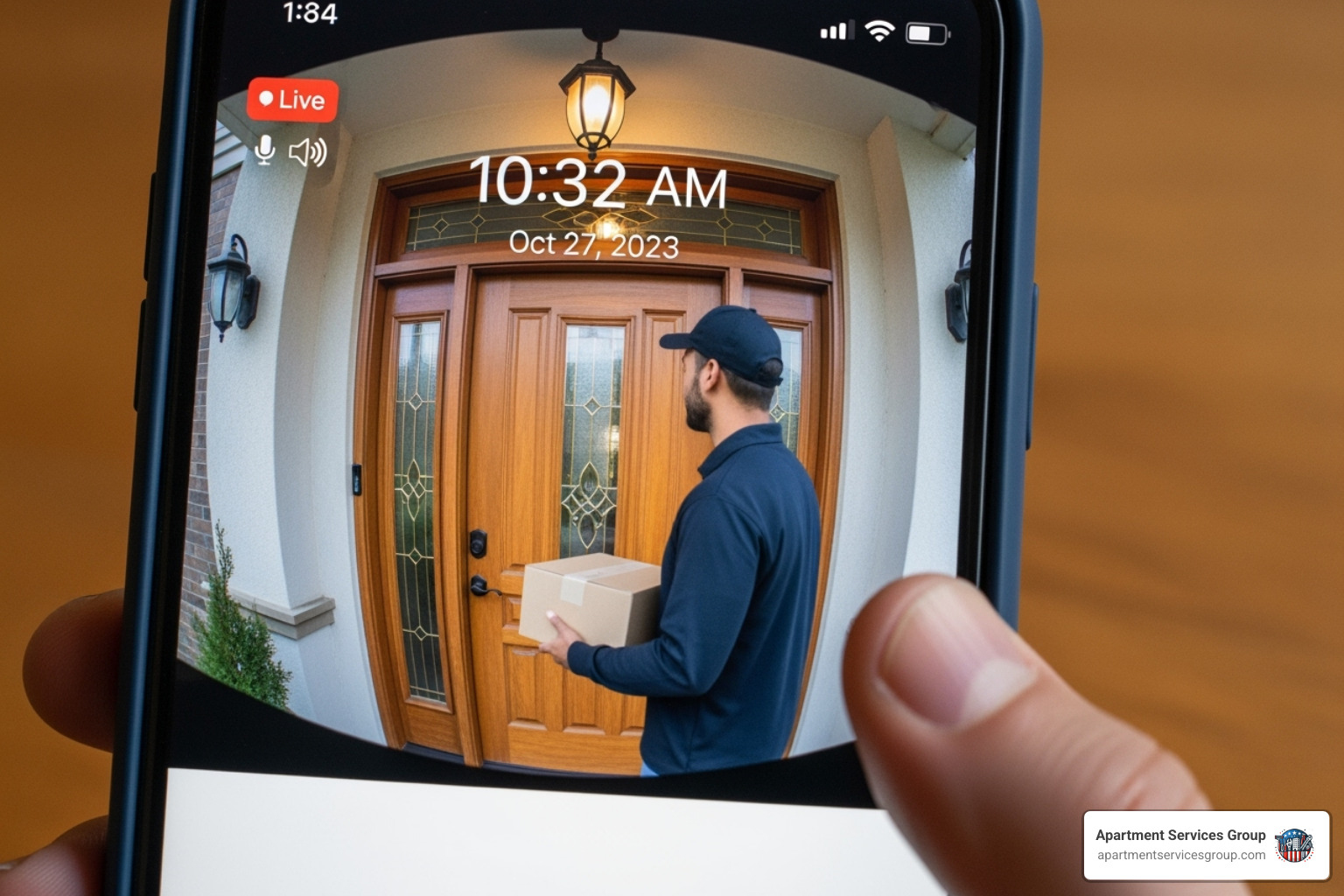Apartment break-in prevention: Peace of Mind 2025
Why Apartment Break-In Prevention Matters More Than Ever
Apartment break-in prevention is critical for renters, who face higher burglary risks than homeowners. FBI data shows most burglaries happen on summer weekdays between 10 a.m. and 3 p.m. Since nearly 40% of unlawful entries occur through open uped doors or windows, apartments with shared access points are especially vulnerable.
Quick apartment break-in prevention essentials:
- Secure entry points with quality deadbolts and window locks.
- Use doorbell cameras and smart lighting for deterrence.
- Know your neighbors for community watch protection.
- Keep blinds closed to hide valuables.
- Install renter-friendly security systems.
- Maintain renters insurance for financial protection.
The reality is stark: burglars spend less than 10 minutes inside, grabbing an average of $2,316 in valuables. Buildings with 2-4 units see the highest burglary rates. The encouraging news is that most break-ins are crimes of opportunity that simple security measures can prevent.
The fear and violation felt after a break-in is something no one should experience. Fortunately, effective apartment security doesn’t require major renovations or expensive equipment.
I’m Moe Shariff, and through my experience with Apartment Services Group, I’ve helped Houston property managers and residents implement comprehensive security strategies. The most effective approach combines physical improvements, smart technology, and community awareness.
Understanding the Burglar’s Playbook
To improve apartment break-in prevention, you must first understand how burglars think. They are opportunists looking for easy targets, quick profits, and minimal risk. They aren’t master criminals; they’re looking for the path of least resistance.
When burglars prefer to work might surprise you. Most burglaries occur during daytime hours between 10 a.m. and 3 p.m., when most people are at work or school. The summer months also see a spike in break-ins, as more people are away on vacation.
According to the 2019 FBI Crime Report, nearly 40% of unlawful entries happen through open uped doors and windows. Burglars often don’t need to “break” in; they simply walk or climb through an open entry point.
Once inside, they want a quick entry and exit, typically taking just five to ten minutes. They grab small, valuable items like jewelry, cash, and electronics, with the average loss value being $2,316.
Ground-floor apartments face higher risks, but upper floors aren’t completely safe. Burglars can access balconies via external staircases or nearby trees. Smaller buildings with 2-4 units experience the highest burglary rates, as they often have fewer security measures. Since most burglars use simple tools like screwdrivers, basic security improvements are highly effective at deterring them.
For Houston residents, understanding local crime patterns is vital. You can learn more about regional security through our Apartment Security Houston services. By understanding a burglar’s methods, you can make your apartment a less appealing target.
Fortifying Your Entry Points: Doors, Windows, and Locks
Since nearly 40% of break-ins happen through open uped or forced entry points, strengthening these barriers is crucial for apartment break-in prevention. Making entry difficult, time-consuming, and noisy will deter most burglars.
Essential Physical Security for Apartment Break-In Prevention
- Deadbolt Locks: Your first line of defense. Look for Grade 1 deadbolts, the toughest security standard. You can find certified options in a directory of certified products. Ensure the bolt has at least a 1-inch throw.
- Strike Plates: A great deadbolt is useless if the strike plate is weak. Replace the short default screws with 3-inch steel screws that anchor deep into the door frame’s stud.
- Door Material: Solid core wood or metal-clad doors offer far more protection than hollow-core doors.
- Window Security: All windows, especially on ground floors, need sturdy locks. For sliding windows and doors, use a security bar or wooden dowel in the track. Consider anti-lift devices for sliding doors.
- Peepholes: A wide-angle (180-degree) peephole lets you safely identify visitors without opening the door.
Renter-Friendly Reinforcements:
- Door reinforcement locks and portable jammers.
- Door stop alarms that sound when the door is opened.
- Window security film to make glass shatter-resistant.
- Wireless door and window sensors that send alerts to your phone.
Securing Your Space Before You Sign
Effective apartment break-in prevention starts before you move in. Use your pre-lease walkthrough as a security audit.
During your inspection, test every lock on doors and windows. Ask the landlord if the locks have been rekeyed since the last tenant; if not, request it. A responsible landlord should handle this automatically.
Also, check common area security. Well-lit hallways, stairwells, and parking areas are crime deterrents. Ensure exterior doors lock properly and look for security cameras. The National Crime Prevention Council checklist is an excellent guide for this process. A landlord who is responsive to security concerns is a good sign. If they seem reluctant, consider it a red flag.
Your Guide to Effective Apartment Break-In Prevention
Effective apartment break-in prevention involves creating layers of security. The goal is to make your apartment seem occupied, well-protected, and too much trouble for a burglar. Visible security measures and an active community are powerful deterrents.
Smart Technology for Apartment Break-In Prevention
Modern smart security devices are often renter-friendly and can be installed without permanent changes.
- Doorbell cameras are game-changers. They let you see, talk to, and record anyone at your door, deterring both burglars and package thieves.
- Smart locks offer remote access control but require landlord approval. Many new models can replace existing deadbolts without permanent modification.
- Entry and motion sensors are simple, effective, and easy to install. They stick to doors and windows and send alerts to your phone if triggered.
- Smart plugs for lights allow you to set schedules to make it look like someone is home, varying the times and rooms for a natural effect.
Many properties offer integrated security systems with professional support. For more on how access control can benefit entire communities, see More info about Apartment Access Control.
Making Your Apartment Look Occupied
Burglars often scout locations, so making your apartment consistently appear occupied is key.
- Use light timers or smart plugs to vary lighting in different rooms.
- Leave a radio or TV on at a conversational volume.
- Keep blinds and curtains closed, especially at night, to prevent outsiders from seeing your valuables or routines.
- Manage mail and packages. An overflowing mailbox is a clear sign you’re away. Ask a neighbor for help or use secure package lockers if your complex provides them.
- Be careful on social media. Avoid broadcasting your travel plans. Save vacation posts for after you return.
The Power of Community and Awareness
Technology is great, but human connection is a powerful security tool.
- Get to know your neighbors. Exchange contact info and agree to watch out for each other. This informal neighborhood watch can spot suspicious activity early.
- Join online community groups on platforms like Nextdoor to stay connected with residents.
- Use intercoms wisely. Never buzz someone in without verifying who they are. Thieves often ring multiple buzzers hoping someone will grant them access.
- Report suspicious activity. Trust your instincts. Contact property management or call 911 if you feel there’s an immediate threat.
- Verify maintenance staff. Legitimate workers should have uniforms, photo IDs, and you should be notified of their visit. Always confirm with your property manager before opening your door.
The Final Layers of Defense: Valuables and Insurance
Even with strong apartment break-in prevention measures, it’s wise to have a backup plan. Protecting your valuables and having solid insurance coverage are essential parts of your security strategy to minimize potential losses if a break-in occurs.
Securing Valuables and Important Documents
Since burglars work quickly, make it hard for them to find your valuables.
- Document everything. Create a detailed inventory of your valuables with photos, videos, and serial numbers. Store this list in the cloud or a safety deposit box. This is crucial for police reports and insurance claims.
- Use secure storage. Take advantage of any secure storage units or lockers your apartment complex offers.
- Invest in a safe. For important documents and irreplaceable items, use a quality fireproof safe. If permitted, bolt it to the floor or wall, as portable safes can be easily stolen.
- Avoid obvious hiding spots. Burglars know to check bedrooms, mattresses, and freezers. Get creative with your hiding places.
Why Renter’s Insurance is Non-Negotiable
Renter’s insurance is an affordable and essential financial safety net. Many property management companies require it as part of the lease.
- Personal Property Coverage: Helps you replace stolen or damaged belongings without paying entirely out-of-pocket.
- Liability Protection: Covers legal and medical expenses if someone is injured in your apartment or if you accidentally cause damage to another unit.
- Additional Living Expenses: Pays for temporary housing and other costs if your apartment becomes uninhabitable due to a covered event like a fire or break-in.
For about $15-20 per month, renter’s insurance provides thousands of dollars in protection and priceless peace of mind. Consult with your property management for recommended providers or specific requirements.
Frequently Asked Questions about Apartment Security
Here are answers to common questions about apartment break-in prevention.
How can I secure my ground-floor apartment?
Ground-floor units require extra attention. Prioritize window security with strong locks, wireless entry sensors, and security film. Always keep blinds closed when you’re away. Ask property management to trim any overgrown landscaping near windows that could provide cover for a burglar. For patio doors, use a security bar in the track and ask about anti-lift devices. Good exterior lighting and knowing your neighbors are also powerful deterrents.
Can I change the locks in my apartment?
You must get permission from your landlord or property manager first, as most leases prohibit tenants from changing locks. This ensures management has emergency access for maintenance and safety. A better solution is to request a rekey, which changes the lock mechanism so old keys no longer work. Reputable property managers often do this between tenants, but it’s always good to ask and confirm.
Are “Beware of Dog” signs effective for apartments?
While a real, barking dog is an excellent deterrent because it creates noise and attention, a sign by itself has limited effect. In a large complex, a burglar can’t see or hear a dog from the entrance. The sign won’t hurt, but it’s no substitute for strong physical security, smart technology, and community awareness. Don’t rely on a sign as your primary defense.
Secure Your Peace of Mind
Taking control of your apartment break-in prevention is achievable. By understanding how burglars think, fortifying entry points, using smart technology, and building community connections, you create powerful layers of security. You are not powerless against this threat.
Start with the basics that make the biggest difference: install 3-inch screws in your door’s strike plates, keep your blinds closed, and get to know your neighbors. These simple, low-cost steps make your apartment a much harder target. Combined with a renter’s insurance policy, you create a robust safety net.
At Apartment Services Group, we help Houston property managers implement comprehensive security solutions that make residents feel safer and more connected. Most burglaries are preventable crimes of opportunity. By making your apartment look occupied and difficult to enter, you encourage intruders to move on.
Security is an ongoing process. Make it a habit to check your locks, update your valuables inventory, and stay connected with your community. These consistent actions are the key to long-term safety.
Ready to take your apartment security to the next level? Learn more about our comprehensive apartment complex solutions to see how we help property managers create safer communities for everyone.











